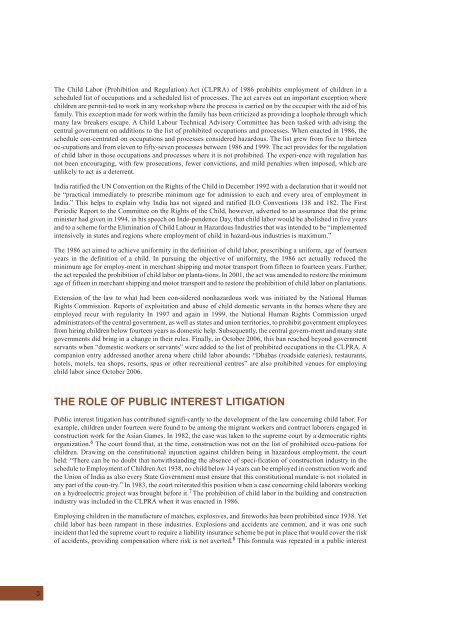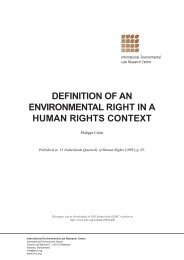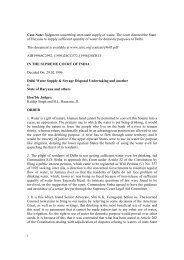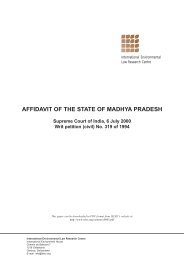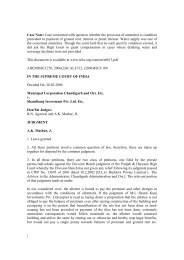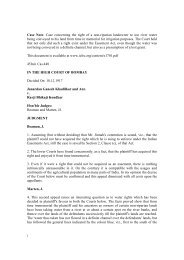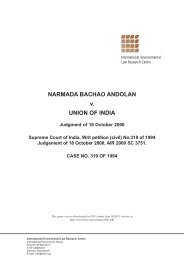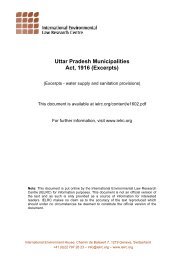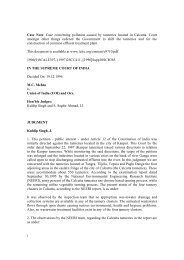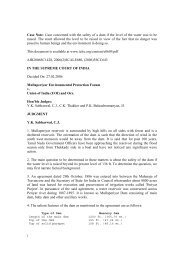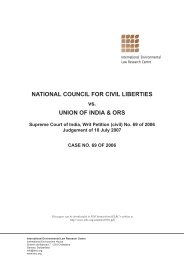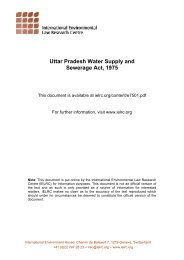Evolution of the Law on Child Labor in India - International ...
Evolution of the Law on Child Labor in India - International ...
Evolution of the Law on Child Labor in India - International ...
You also want an ePaper? Increase the reach of your titles
YUMPU automatically turns print PDFs into web optimized ePapers that Google loves.
The <strong>Child</strong> <strong>Labor</strong> (Prohibiti<strong>on</strong> and Regulati<strong>on</strong>) Act (CLPRA) <str<strong>on</strong>g>of</str<strong>on</strong>g> 1986 prohibits employment <str<strong>on</strong>g>of</str<strong>on</strong>g> children <strong>in</strong> ascheduled list <str<strong>on</strong>g>of</str<strong>on</strong>g> occupati<strong>on</strong>s and a scheduled list <str<strong>on</strong>g>of</str<strong>on</strong>g> processes. The act carves out an important excepti<strong>on</strong> wherechildren are permit-ted to work <strong>in</strong> any workshop where <str<strong>on</strong>g>the</str<strong>on</strong>g> process is carried <strong>on</strong> by <str<strong>on</strong>g>the</str<strong>on</strong>g> occupier with <str<strong>on</strong>g>the</str<strong>on</strong>g> aid <str<strong>on</strong>g>of</str<strong>on</strong>g> hisfamily. This excepti<strong>on</strong> made for work with<strong>in</strong> <str<strong>on</strong>g>the</str<strong>on</strong>g> family has been criticized as provid<strong>in</strong>g a loophole through whichmany law breakers escape. A <strong>Child</strong> Labour Technical Advisory Committee has been tasked with advis<strong>in</strong>g <str<strong>on</strong>g>the</str<strong>on</strong>g>central government <strong>on</strong> additi<strong>on</strong>s to <str<strong>on</strong>g>the</str<strong>on</strong>g> list <str<strong>on</strong>g>of</str<strong>on</strong>g> prohibited occupati<strong>on</strong>s and processes. When enacted <strong>in</strong> 1986, <str<strong>on</strong>g>the</str<strong>on</strong>g>schedule c<strong>on</strong>-centrated <strong>on</strong> occupati<strong>on</strong>s and processes c<strong>on</strong>sidered hazardous. The list grew from five to thirteenoc-cupati<strong>on</strong>s and from eleven to fifty-seven processes between 1986 and 1999. The act provides for <str<strong>on</strong>g>the</str<strong>on</strong>g> regulati<strong>on</strong><str<strong>on</strong>g>of</str<strong>on</strong>g> child labor <strong>in</strong> those occupati<strong>on</strong>s and processes where it is not prohibited. The experi-ence with regulati<strong>on</strong> hasnot been encourag<strong>in</strong>g, with few prosecuti<strong>on</strong>s, fewer c<strong>on</strong>victi<strong>on</strong>s, and mild penalties when imposed, which areunlikely to act as a deterrent.<strong>India</strong> ratified <str<strong>on</strong>g>the</str<strong>on</strong>g> UN C<strong>on</strong>venti<strong>on</strong> <strong>on</strong> <str<strong>on</strong>g>the</str<strong>on</strong>g> Rights <str<strong>on</strong>g>of</str<strong>on</strong>g> <str<strong>on</strong>g>the</str<strong>on</strong>g> <strong>Child</strong> <strong>in</strong> December 1992 with a declarati<strong>on</strong> that it would notbe “practical immediately to prescribe m<strong>in</strong>imum age for admissi<strong>on</strong> to each and every area <str<strong>on</strong>g>of</str<strong>on</strong>g> employment <strong>in</strong><strong>India</strong>.” This helps to expla<strong>in</strong> why <strong>India</strong> has not signed and ratified ILO C<strong>on</strong>venti<strong>on</strong>s 138 and 182. The FirstPeriodic Report to <str<strong>on</strong>g>the</str<strong>on</strong>g> Committee <strong>on</strong> <str<strong>on</strong>g>the</str<strong>on</strong>g> Rights <str<strong>on</strong>g>of</str<strong>on</strong>g> <str<strong>on</strong>g>the</str<strong>on</strong>g> <strong>Child</strong>, however, adverted to an assurance that <str<strong>on</strong>g>the</str<strong>on</strong>g> primem<strong>in</strong>ister had given <strong>in</strong> 1994, <strong>in</strong> his speech <strong>on</strong> Inde-pendence Day, that child labor would be abolished <strong>in</strong> five yearsand to a scheme for <str<strong>on</strong>g>the</str<strong>on</strong>g> Elim<strong>in</strong>ati<strong>on</strong> <str<strong>on</strong>g>of</str<strong>on</strong>g> <strong>Child</strong> Labour <strong>in</strong> Hazardous Industries that was <strong>in</strong>tended to be “implemented<strong>in</strong>tensively <strong>in</strong> states and regi<strong>on</strong>s where employment <str<strong>on</strong>g>of</str<strong>on</strong>g> child <strong>in</strong> hazard-ous <strong>in</strong>dustries is maximum.”The 1986 act aimed to achieve uniformity <strong>in</strong> <str<strong>on</strong>g>the</str<strong>on</strong>g> def<strong>in</strong>iti<strong>on</strong> <str<strong>on</strong>g>of</str<strong>on</strong>g> child labor, prescrib<strong>in</strong>g a uniform, age <str<strong>on</strong>g>of</str<strong>on</strong>g> fourteenyears <strong>in</strong> <str<strong>on</strong>g>the</str<strong>on</strong>g> def<strong>in</strong>iti<strong>on</strong> <str<strong>on</strong>g>of</str<strong>on</strong>g> a child. In pursu<strong>in</strong>g <str<strong>on</strong>g>the</str<strong>on</strong>g> objective <str<strong>on</strong>g>of</str<strong>on</strong>g> uniformity, <str<strong>on</strong>g>the</str<strong>on</strong>g> 1986 act actually reduced <str<strong>on</strong>g>the</str<strong>on</strong>g>m<strong>in</strong>imum age for employ-ment <strong>in</strong> merchant shipp<strong>in</strong>g and motor transport from fifteen to fourteen years. Fur<str<strong>on</strong>g>the</str<strong>on</strong>g>r,<str<strong>on</strong>g>the</str<strong>on</strong>g> act repealed <str<strong>on</strong>g>the</str<strong>on</strong>g> prohibiti<strong>on</strong> <str<strong>on</strong>g>of</str<strong>on</strong>g> child labor <strong>on</strong> planta-ti<strong>on</strong>s. In 2001, <str<strong>on</strong>g>the</str<strong>on</strong>g> act was amended to restore <str<strong>on</strong>g>the</str<strong>on</strong>g> m<strong>in</strong>imumage <str<strong>on</strong>g>of</str<strong>on</strong>g> fifteen <strong>in</strong> merchant shipp<strong>in</strong>g and motor transport and to restore <str<strong>on</strong>g>the</str<strong>on</strong>g> prohibiti<strong>on</strong> <str<strong>on</strong>g>of</str<strong>on</strong>g> child labor <strong>on</strong> plantati<strong>on</strong>s.Extensi<strong>on</strong> <str<strong>on</strong>g>of</str<strong>on</strong>g> <str<strong>on</strong>g>the</str<strong>on</strong>g> law to what had been c<strong>on</strong>-sidered n<strong>on</strong>hazardous work was <strong>in</strong>itiated by <str<strong>on</strong>g>the</str<strong>on</strong>g> Nati<strong>on</strong>al HumanRights Commissi<strong>on</strong>. Reports <str<strong>on</strong>g>of</str<strong>on</strong>g> exploitati<strong>on</strong> and abuse <str<strong>on</strong>g>of</str<strong>on</strong>g> child domestic servants <strong>in</strong> <str<strong>on</strong>g>the</str<strong>on</strong>g> homes where <str<strong>on</strong>g>the</str<strong>on</strong>g>y areemployed recur with regularity In 1997 and aga<strong>in</strong> <strong>in</strong> 1999, <str<strong>on</strong>g>the</str<strong>on</strong>g> Nati<strong>on</strong>al Human Rights Commissi<strong>on</strong> urgedadm<strong>in</strong>istrators <str<strong>on</strong>g>of</str<strong>on</strong>g> <str<strong>on</strong>g>the</str<strong>on</strong>g> central government, as well as states and uni<strong>on</strong> territories, to prohibit government employeesfrom hir<strong>in</strong>g children below fourteen years as domestic help. Subsequently, <str<strong>on</strong>g>the</str<strong>on</strong>g> central govern-ment and many stategovernments did br<strong>in</strong>g <strong>in</strong> a change <strong>in</strong> <str<strong>on</strong>g>the</str<strong>on</strong>g>ir rules. F<strong>in</strong>ally, <strong>in</strong> October 2006, this ban reached bey<strong>on</strong>d governmentservants when “domestic workers or servants” were added to <str<strong>on</strong>g>the</str<strong>on</strong>g> list <str<strong>on</strong>g>of</str<strong>on</strong>g> prohibited occupati<strong>on</strong>s <strong>in</strong> <str<strong>on</strong>g>the</str<strong>on</strong>g> CLPRA. Acompani<strong>on</strong> entry addressed ano<str<strong>on</strong>g>the</str<strong>on</strong>g>r arena where child labor abounds: “Dhabas (roadside eateries), restaurants,hotels, motels, tea shops, resorts, spas or o<str<strong>on</strong>g>the</str<strong>on</strong>g>r recreati<strong>on</strong>al centres” are also prohibited venues for employ<strong>in</strong>gchild labor s<strong>in</strong>ce October 2006.THE ROLE OF PUBLIC INTEREST LITIGATIONPublic <strong>in</strong>terest litigati<strong>on</strong> has c<strong>on</strong>tributed signifi-cantly to <str<strong>on</strong>g>the</str<strong>on</strong>g> development <str<strong>on</strong>g>of</str<strong>on</strong>g> <str<strong>on</strong>g>the</str<strong>on</strong>g> law c<strong>on</strong>cern<strong>in</strong>g child labor. Forexample, children under fourteen were found to be am<strong>on</strong>g <str<strong>on</strong>g>the</str<strong>on</strong>g> migrant workers and c<strong>on</strong>tract laborers engaged <strong>in</strong>c<strong>on</strong>structi<strong>on</strong> work for <str<strong>on</strong>g>the</str<strong>on</strong>g> Asian Games. In 1982, <str<strong>on</strong>g>the</str<strong>on</strong>g> case was taken to <str<strong>on</strong>g>the</str<strong>on</strong>g> supreme court by a democratic rightsorganizati<strong>on</strong>. 6 The court found that, at <str<strong>on</strong>g>the</str<strong>on</strong>g> time, c<strong>on</strong>structi<strong>on</strong> was not <strong>on</strong> <str<strong>on</strong>g>the</str<strong>on</strong>g> list <str<strong>on</strong>g>of</str<strong>on</strong>g> prohibited occu-pati<strong>on</strong>s forchildren. Draw<strong>in</strong>g <strong>on</strong> <str<strong>on</strong>g>the</str<strong>on</strong>g> c<strong>on</strong>stituti<strong>on</strong>al <strong>in</strong>juncti<strong>on</strong> aga<strong>in</strong>st children be<strong>in</strong>g <strong>in</strong> hazardous employment, <str<strong>on</strong>g>the</str<strong>on</strong>g> cour<str<strong>on</strong>g>the</str<strong>on</strong>g>ld: “There can be no doubt that notwithstand<strong>in</strong>g <str<strong>on</strong>g>the</str<strong>on</strong>g> absence <str<strong>on</strong>g>of</str<strong>on</strong>g> speci-ficati<strong>on</strong> <str<strong>on</strong>g>of</str<strong>on</strong>g> c<strong>on</strong>structi<strong>on</strong> <strong>in</strong>dustry <strong>in</strong> <str<strong>on</strong>g>the</str<strong>on</strong>g>schedule to Employment <str<strong>on</strong>g>of</str<strong>on</strong>g> <strong>Child</strong>ren Act 1938, no child below 14 years can be employed <strong>in</strong> c<strong>on</strong>structi<strong>on</strong> work and<str<strong>on</strong>g>the</str<strong>on</strong>g> Uni<strong>on</strong> <str<strong>on</strong>g>of</str<strong>on</strong>g> <strong>India</strong> as also every State Government must ensure that this c<strong>on</strong>stituti<strong>on</strong>al mandate is not violated <strong>in</strong>any part <str<strong>on</strong>g>of</str<strong>on</strong>g> <str<strong>on</strong>g>the</str<strong>on</strong>g> coun-try.” In 1983, <str<strong>on</strong>g>the</str<strong>on</strong>g> court reiterated this positi<strong>on</strong> when a case c<strong>on</strong>cern<strong>in</strong>g child laborers work<strong>in</strong>g<strong>on</strong> a hydroelectric project was brought before it. 7 The prohibiti<strong>on</strong> <str<strong>on</strong>g>of</str<strong>on</strong>g> child labor <strong>in</strong> <str<strong>on</strong>g>the</str<strong>on</strong>g> build<strong>in</strong>g and c<strong>on</strong>structi<strong>on</strong><strong>in</strong>dustry was <strong>in</strong>cluded <strong>in</strong> <str<strong>on</strong>g>the</str<strong>on</strong>g> CLPRA when it was enacted <strong>in</strong> 1986.Employ<strong>in</strong>g children <strong>in</strong> <str<strong>on</strong>g>the</str<strong>on</strong>g> manufacture <str<strong>on</strong>g>of</str<strong>on</strong>g> matches, explosives, and fireworks has been prohibited s<strong>in</strong>ce 1938. Yetchild labor has been rampant <strong>in</strong> <str<strong>on</strong>g>the</str<strong>on</strong>g>se <strong>in</strong>dustries. Explosi<strong>on</strong>s and accidents are comm<strong>on</strong>, and it was <strong>on</strong>e such<strong>in</strong>cident that led <str<strong>on</strong>g>the</str<strong>on</strong>g> supreme court to require a liability <strong>in</strong>surance scheme be put <strong>in</strong> place that would cover <str<strong>on</strong>g>the</str<strong>on</strong>g> risk<str<strong>on</strong>g>of</str<strong>on</strong>g> accidents, provid<strong>in</strong>g compensati<strong>on</strong> where risk is not averted. 8 This formula was repeated <strong>in</strong> a public <strong>in</strong>terest3


